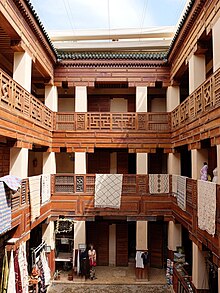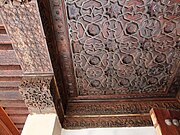
The Funduq al-Tetwaniyyin (Arabic: فندق التطوانيين, lit. 'caravanserai of the people of Tetouan'), also known as the Funduq al-Staouniyine, is a historic funduq (caravanserai) in Fes el-Bali, the old city of Fes, Morocco.
Historical background

The funduq is located next to the al-Qarawiyyin Mosque, facing its northeastern corner and close to the Mesbahiyya Madrasa. It was founded in the 14th century during the Marinid era, probably around the same time as the construction of the al-Attarine Madrasa by Sultan Abu Sa'id Uthman II, making it one of the oldest funduqs in Fes. It was probably called Funduq er-Ridā' in the medieval period.
Funduqs were a type of urban caravanserai in Morocco which served as an inn and commercial center for trade, providing services and accommodations for merchants and travelers from outside the city. Some funduqs were also occupied by artisans and manufacturers instead of merchants, but the Staouniyyin Funduq was solely for merchants. The name Tetwaniyyin means "people from Tetouan" (a city in northern Morocco), suggesting that merchants in Fes were historically grouped together by origin.
The building was classified as a national monument in 1925. It was more recently restored, along with a number of other funduqs, by the ADER-Fes heritage preservation agency, and reopened in March 2019 as a cultural and commercial center for artisans, with some modern amenities added.
Architecture
The funduq has a typical layout that matches other caravanserais in Morocco and in Nasrid Granada at the time, consisting of a courtyard surrounded by a multi-storied gallery that gives access to rooms arranged across its three floors. It has a usable floor area (after recent restorations) of 437 square metres. The galleries are supported by wooden lintels resting on square pillars, and are lined with wooden mashrabiya-like railings or parapets. The ground floor was most likely used for storage of animals and merchandise, and was the site of trading and commerce, while the upper floors were for sleeping accommodations.
The building is also noted for its vestibule, which has a ceiling of carved and painted wood featuring geometric and floral motifs, as well as an Arabic inscription carved in Kufic script. The woodcarving of the corbels on the courtyard side of the vestibule is especially sophisticated and is among the finest surviving examples from the Marinid period.
- Carved woodwork in the vestibule
-
 Wooden ceiling of the vestibule, with elements of original Marinid-era woodwork
Wooden ceiling of the vestibule, with elements of original Marinid-era woodwork
-
 Detail of the wooden corbels in the vestibule
Detail of the wooden corbels in the vestibule
-
 Carved Kufic inscription and vegetal motifs
Carved Kufic inscription and vegetal motifs
See also
Notes
- The name is transliterated in various ways by different authors, including: Fondok Tettawniyin Fondouc at-Tattawiniyn Fondouk Tattawiyin Foundouk Tetouaniyine and Funduq al-Tattawaniyyin.
- Also transliterated as Funduq al-Stawinyin.
References
- ^ Le Tourneau, Roger (1949). Fès avant le protectorat : étude économique et sociale d'une ville de l'occident musulman (in French). Casablanca: Société Marocaine de Librairie et d'Édition. pp. 72, 134, 318.
- ^ Marçais, Georges (1954). L'architecture musulmane d'Occident. Paris: Arts et métiers graphiques. p. 315.
- ^ Gaudio, Attilio (1982). Fès: Joyau de la civilisation islamique (in French). Paris: Les Presse de l'UNESCO: Nouvelles Éditions Latines. pp. 25 (for location), 203. ISBN 2723301591.
- "Foundouk Tetouaniyine ( l'Entrée )". Inventaire et Documentation du Patrimoine Cultural du Maroc (in French). Archived from the original on 2020-04-07. Retrieved 2020-04-07.
- ^ Salmon, Xavier (2021). Fès mérinide: Une capitale pour les arts, 1276-1465 (in French). Lienart. pp. 306–307. ISBN 9782359063356.
- "Fez Old Medina Revamp: Unwavering Will by HM the King to Preserve Ancient City". Maroc.ma. 2019-04-17. Retrieved 2024-02-03.
- Gilbert, Sarah (2022). Lonely Planet Morocco. Lonely Planet. ISBN 978-1-83869-255-1.
- ^ Touri, Abdelaziz; Benaboud, Mhammad; Boujibar El-Khatib, Naïma; Lakhdar, Kamal; Mezzine, Mohamed (2010). "III.1.f Stauniyin Funduq". Andalusian Morocco: A Discovery in Living Art (2 ed.). Ministry of Cultural Affairs of the Kingdom of Morocco & Museum With No Frontiers. ISBN 978-3902782311.
- "How Fez Is Keeping Traditional Architecture and Craftsmanship Alive". AFAR Media. Retrieved 2020-03-29.
- Temsamani, Said (2019-04-16). "Revival Of Old Medina Of Fez Extends Beyond Its Beauty". Eurasia Review. Retrieved 2020-03-29.
- Idrissi, Mehdi El (2016-03-22). "Fès ressuscite ses foundouks". LesEco.ma (in French). Archived from the original on 2020-03-29. Retrieved 2020-03-29.
External links
- "Medieval inns restored as Moroccan craft markets", Associated Press Archive: contains footage of Funduq Staouniyyin after restoration (first part of video).
- Photo of the funduq's interior in 2023 (Flickr)
34°03′54.2″N 4°58′22.4″W / 34.065056°N 4.972889°W / 34.065056; -4.972889
| Fez, Morocco | |||||||||||||||||||||||||||||||
|---|---|---|---|---|---|---|---|---|---|---|---|---|---|---|---|---|---|---|---|---|---|---|---|---|---|---|---|---|---|---|---|
| Subdivisions |
| ||||||||||||||||||||||||||||||
| History | |||||||||||||||||||||||||||||||
| Transport | |||||||||||||||||||||||||||||||
| Education | |||||||||||||||||||||||||||||||
| Sports |
| ||||||||||||||||||||||||||||||
| Culture | |||||||||||||||||||||||||||||||
| Landmarks |
| ||||||||||||||||||||||||||||||
| People | |||||||||||||||||||||||||||||||